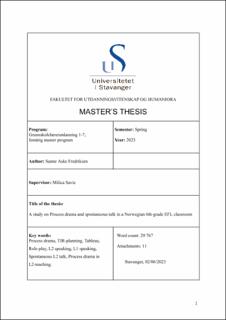| dc.description.abstract | The purpose of this study was to investigate whether Process drama (PD) generated spontaneous talk in an English lesson with five Norwegian 6th-grade second language (L2) learners and how the learners perceived their own oral participation and the set-up of the PD. Thus, this case study aimed to reveal whether the set-up of drama conventions (i.e., Teacher in role (TIR)-planning, Tableau, and Role-play) affected learners’ spontaneous talk and their engagement. There has been little research on PD and spontaneous talk in the L2 classroom in the Norwegian school context. Thus this study aimed to fill the current research gap.
This small-scale case study has been informed by the qualitative paradigm and has drawn on elements of quantitative analysis and participatory research. Data was collected through audio-recordings of in-class group discussions during the three drama conventions. The audio-recordings were transcribed and analyzed with regard to the amount of spontaneous talk in the learners’ first language (L1) and L2, the functions of L1 in the learners’ interactions, as well as the amount of spontaneous talk across the three drama conventions. Furthermore, a focus-group semi-structured interview of the participants’ perceptions of their oral participation and the PD was conducted and analyzed thematically.
The main findings of this study demonstrated that the PD generated L2 spontaneous talk as the participants produced significant amounts of L2 spontaneous talk in the three drama conventions. TIR-planning generated the most L2 spontaneous talk, followed by Tableau and Role-play. Although Role-play generated the least amount of L2 spontaneous talk, the results demonstrate significant use of L2 in all three drama conventions. There have been detected some purposes for the use of L1 (i.e., Answering an L1 statement in L1, Digression, Directing, Clarification, Need of translation, and Explaining themselves), with individual participants using L1 for different purposes. The participants were overall satisfied with their own L2 oral participation, finding it easy to speak their L2 in the drama conventions, especially in the Role-play, as they enjoyed acting and speaking in roles. They uttered very positive opinions of the PD and stated how there should be more drama and play in the L2 classroom. Thus, the findings suggested that teachers should consider implementing PD, or elements of drama, in the L2 classroom to stimulate oral participation and learner engagement. | |
